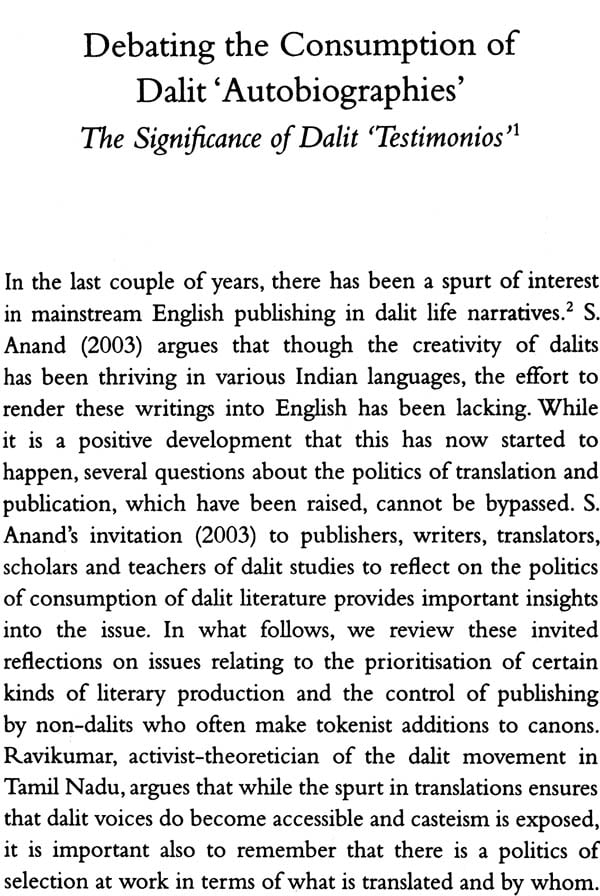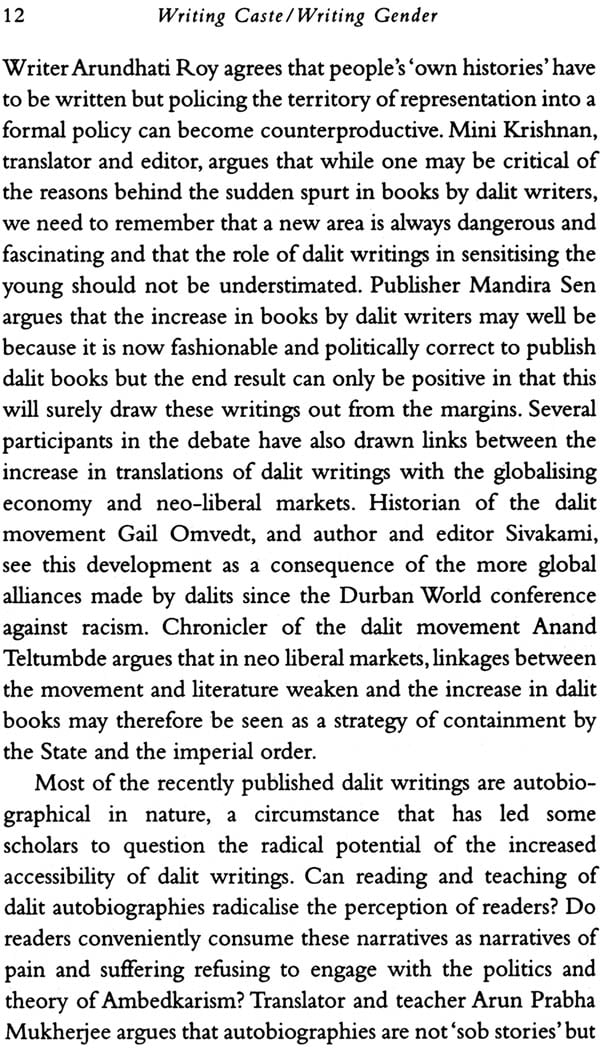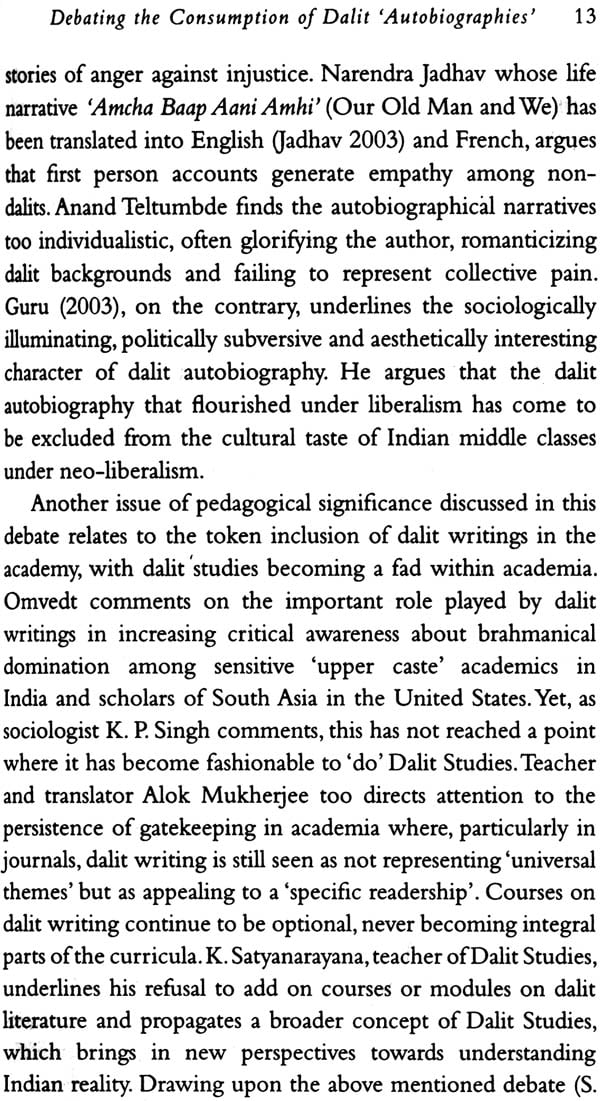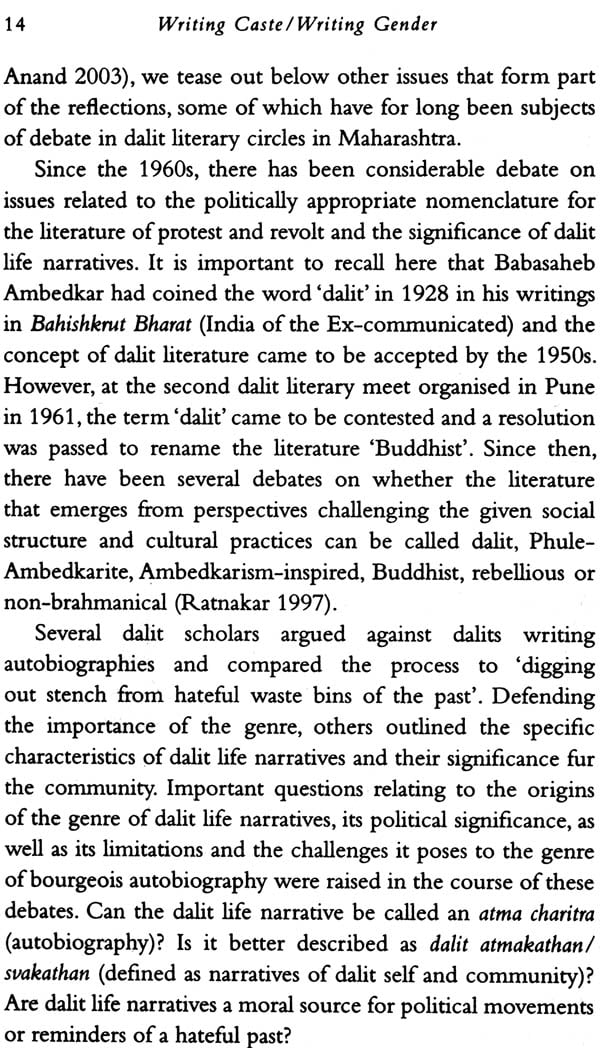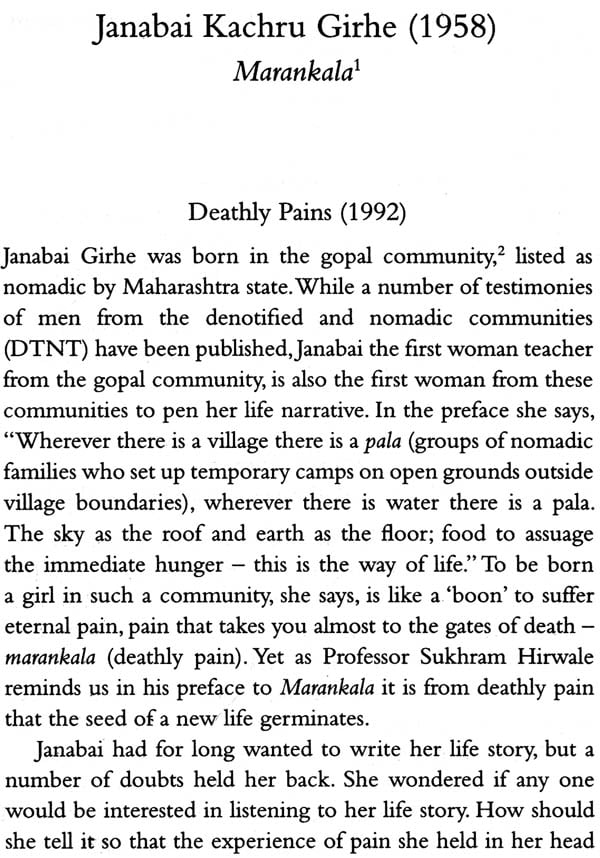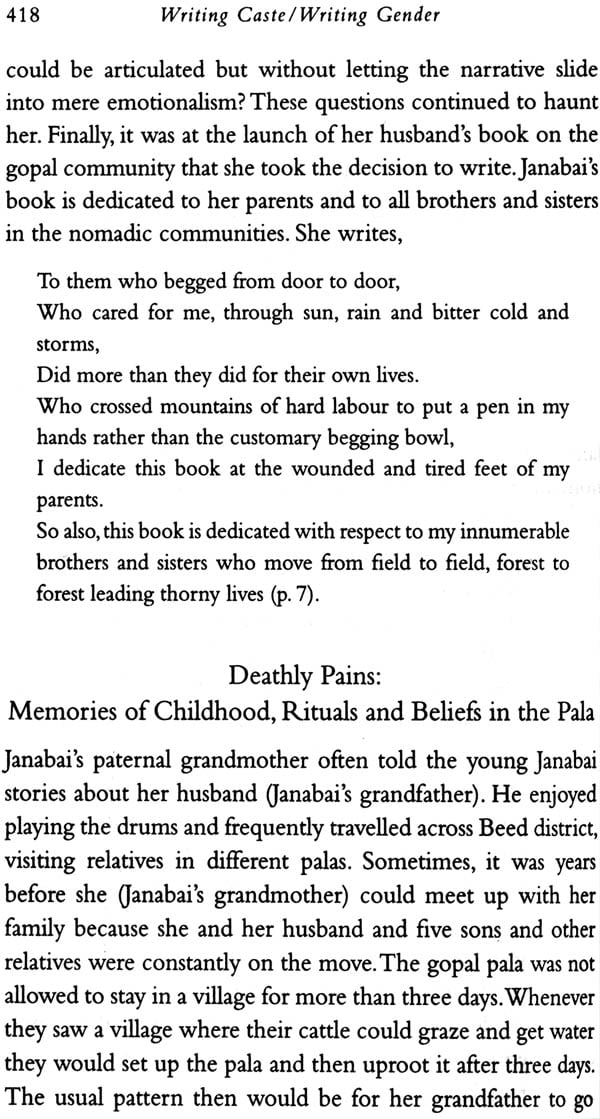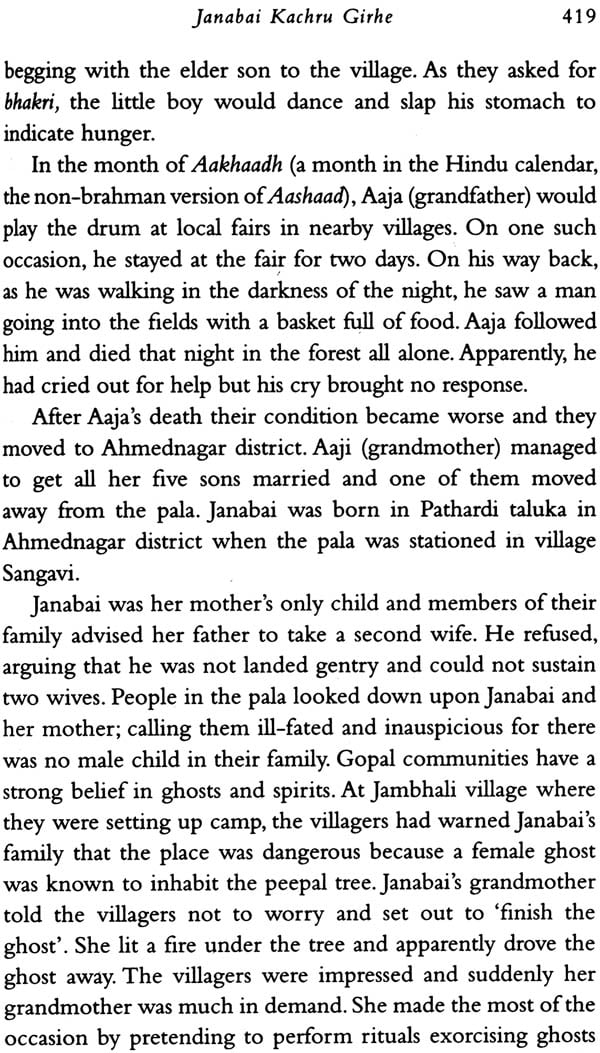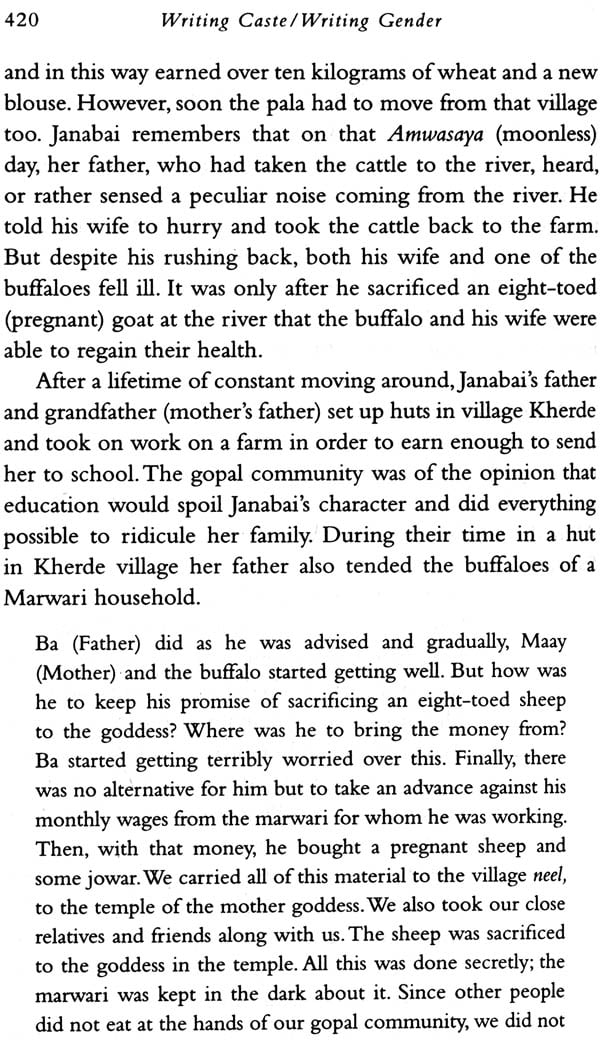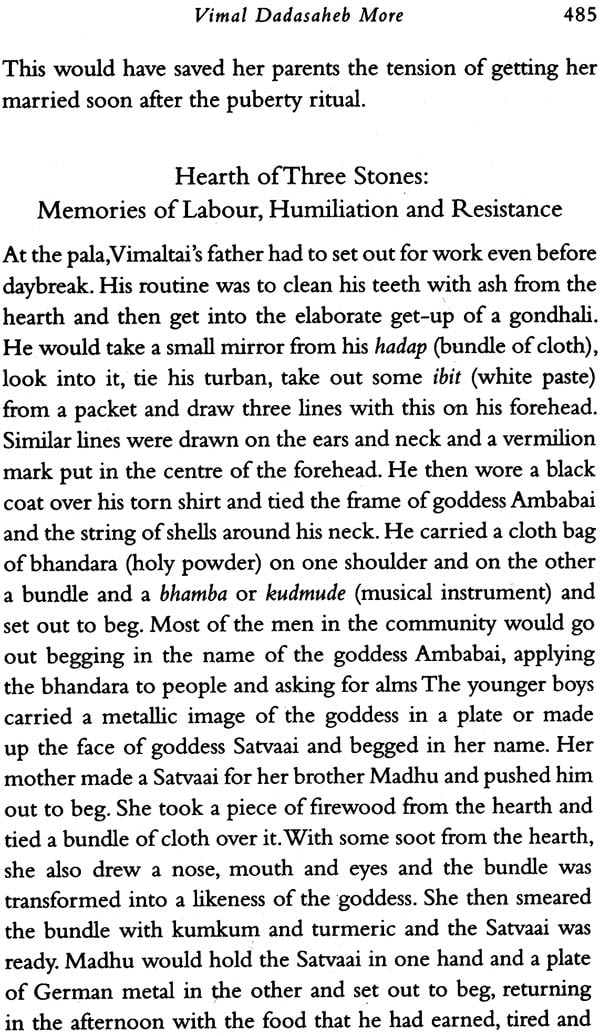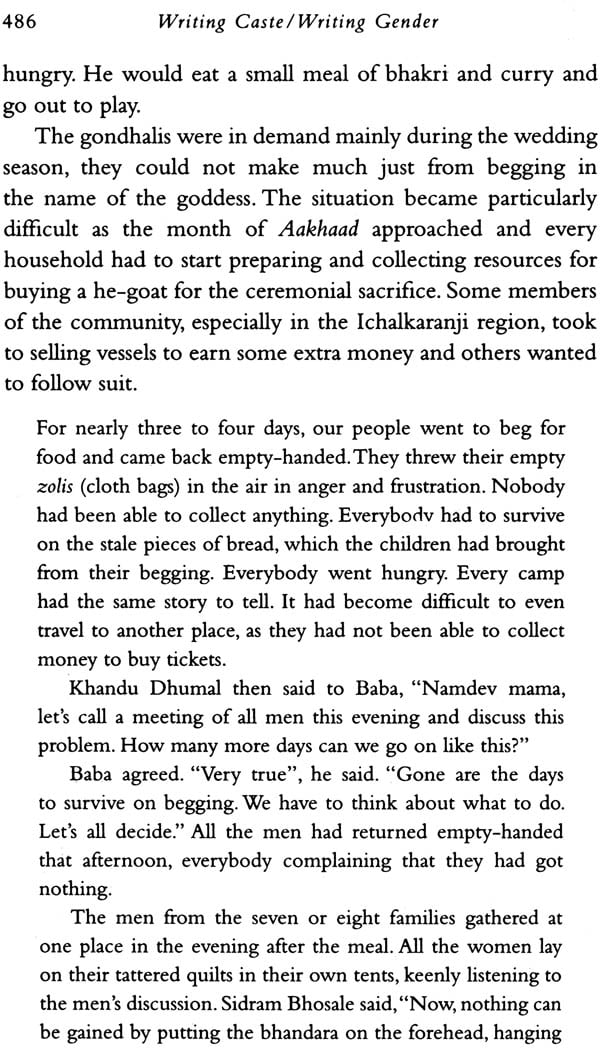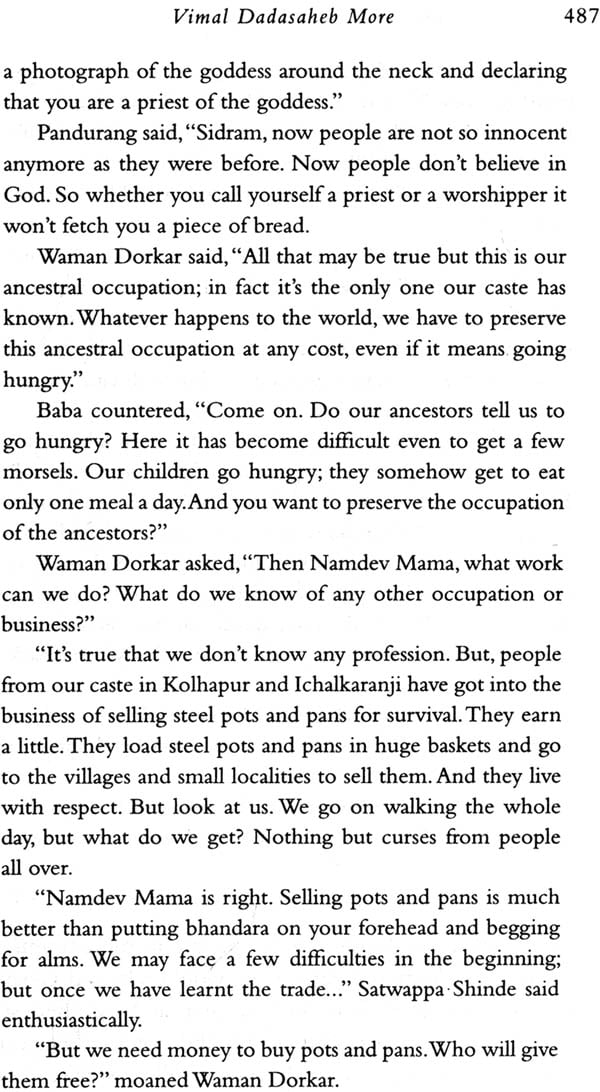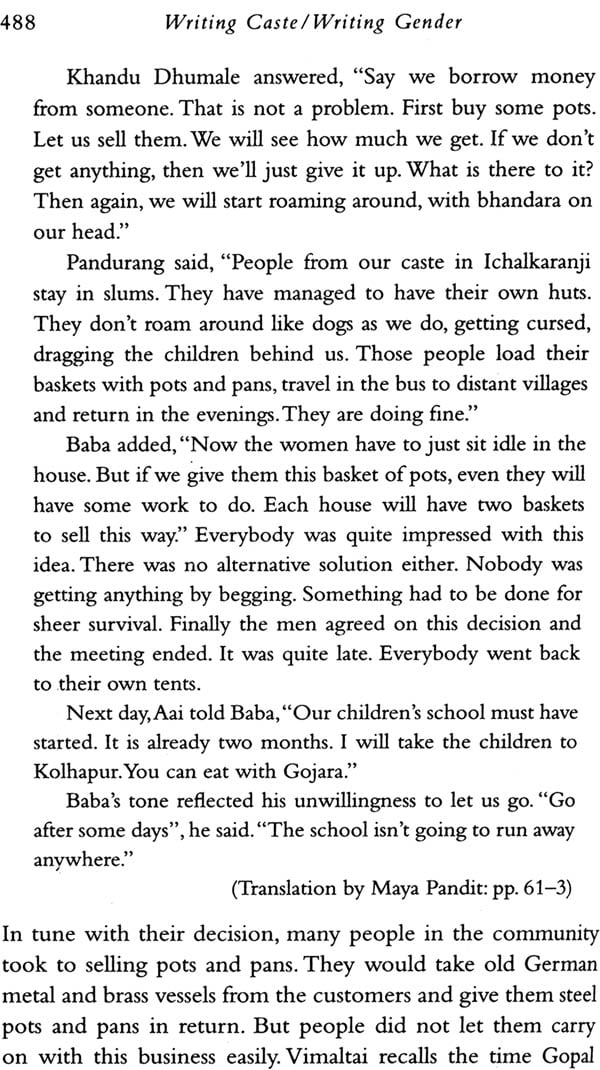
Writing caste/ Writing Gender (Narrating Dalit Women;s Testimonios)
Book Specification
| Item Code: | NAF932 |
| Author: | Sharmila Rege |
| Publisher: | Zubaan Publications |
| Language: | English |
| Edition: | 2013 |
| ISBN: | 9789381017920 |
| Pages: | 540 |
| Cover: | Hardcover |
| Other Details | 8 inch X 5 inch |
| Weight | 420 gm |
Book Description
‘The women tell it like it is… So riveting is the narration that it is difficult to put down the book until their stories are finished. For a non-fiction academic work this is no small feat.’ The Hindu
Shamila Rege’s pathbreaking study of Dalit women’s writings and lives offers a powerful counter-narrative to the mainstream assumption about the development of feminism in India in the 20th century .Extensive extracts from eight Dalit women’s writings cover issues such as food and hunger, community, caste, labour, education, violence, resistance and collective struggle.
The voice that resound throughout the book reveal that Dalit feminism, far from being ‘silent’ as so often presumed, is rich, powerful, layered – and highly articulate.
Early in July of 2013, as we were preparing to send this book to press, Sharmila Rege died. She was forty eight years old, and had been diagnosed with a cancer that did not even give her any time to come to terms with it. During the less than three weeks that she spent in hospital, she was surrounded by her husband, her relatives and her colleagues and students who had kept watch over her as cancer invaded, took over and then destroyed her body.
Sharmila’s life and work are difficult to describe — she touched so many people, reached out to them with a generosity and unselfishness that is as rare as it is precious. As an academic, she constantly pushed against the boundaries and questioned entrenched knowledge systems, posing hard questions about the invisibility of caste and non-brahmin perspectives on caste. Why, she asked, had the world of academics remained so wilfully ignorant of what she called the divide between the ‘theoretical brahmans’ and the ‘empirical shudras’. Going further, she pointed out how important it was for feminists to engage with caste. Indeed, her work on caste and patriarchy was — and remains — perhaps the single most important contribution to the feminist understanding of, and engagement with caste. But Sharmila was so much more than just an academic: she was a teacher for whom nothing was mote important than her students. She taught and spoke to packed halls, she encouraged her students to question, to write, to work in fields related and unrelated to their subject areas, she lobbied all her friends and acquaintances to take her students on as interns, to give them what she called ‘exposure to a different world’, and insisted that those who took them on, make the students work hard.
The Krantijyoti Savitribai Phule Women’s Studies Centre at Pune University became, with Sharmila’s support, one of the most vibrant, intellectually stimulating and active centres in India, organizing lectures, seminars, discussions, plays etc., with regularity and offering up pathbreaking research projects. More recently, Sharmila had begun to widen her ambit and look at South Asia and she was keen to create new courses that took in comparative perspectives on gender and women in South Asia.
With her characteristic warmth and generosity, she had drawn in a number of women across India to contribute to the discussions on this and was keenly involved in preparing to take the project forward. There will, no doubt, be many other things in which Sharmila was involved, and where her contribution would have been crucial. One such was with us: advising Zubaan on a research project on sexual violence and impunity in South Asia, Sharmila offered to take on a literature review and, before anyone else had even begun their work, she had submitted her first draft. And one of her concerns, even in hospital, was about how this work would be completed.
At Zubaan, we interacted with Sharmila for several months when we were working on Writing Caste/Writing Gender: Narrating Dalit Women’s Testimonios (originally published in 2006 and reprinted now as part of the Zubaan Classics series to commemorate our tenth anniversary), and were struck by her constant good humour and her willingness to listen to suggestions, to offer to rework, and to be gently bullied. We often shared a joke about her somewhat quirky use of tenses and our constant battle to change these — a fact she mentions in the introduction to the book.
It’s a truism to say you will miss someone badly — someone who has been so central to the world of feminism, to feminist scholarship, to pedagogy, and someone who has created a different model of participative, cutting edge, against the grain writing. But like all truisms, this one too bears repeating. Sharmila was devastated at the loss of another wonderful feminist, Vina Mazumdar, who died a few weeks before her. Reading a poem written as a tribute to Vina Mazumdar, Sharmila wrote how much she had liked it. She said: ‘we are going to start the semester by reading out [this] poem and pledging to work in the directions charted by Vinadi for all the reasons the poem maps... I was infatuated with her.
In the past few months we have lost both Vinadi and Sharmila. Sharmila will not be around to read the poem on Vinadi to her students, but her legacy, her work, her spirit will continue to inspire us.
The growing number of recently published translations of dalit writings (mainly life narratives), tempt one to think that a rupture of kinds may be taking place in our teaching and learning of caste studies. Two decades ago, for many of us studying social sciences in regional universities in India, caste was considered mainly a ‘sociological’ subject. Undeniably, it was central to the courses on Indian society. At the time, these were neatly compartmentalised into ‘social structure’ and ‘social change’ over two academic terms. The study of caste too was compartmentalised into reading studies on the features of the caste system in one term and modernisation and sanskritisation of caste in the other. Writings on/by Phule, Ambedkar, Periyar were not on the list of readings and most of us remained largely ignorant of the abrahmani/ non-brahmanical perspectives on caste. The Satyashodhak and Ambedkarite movements did not have a place in courses on social movements and the post-independence dalit, tribal and women’s movements were often cluttered into one module. Not surprisingly, there were no selections from dalit literature and life narratives in our readings or classes and therefore the epistemological challenge posed by the dalit movement and literature to received social science frameworks was lost to us. A decade later, as teachers of sociology, we realised that the assumcd Archimedean standpoint for the objective study of caste had persisted and caste in our classrooms continued to be practised much in the same way.
Indian sociology, as Deshpande (2003) has argued, seems to have done little to counter the tendency for caste to vanish from view in those very contexts where it has been most effective. Indian sociology seems to have invited us to ‘see’ caste only in villages, rituals, rites and so on and by doing so, seems to have suggested that caste had no active role in everyday urban life. Since the ‘upper castes’ have dominated urban middle class arenas such as universities and research institutes, caste identity has hardly ever been an issue for public discussion. As an upper caste, middle class student on campus, I recall being part of a group that thought discussions about caste identities to be retrograde. In the women’s movement too, caste was rarely discussed as it was assumed that caste identities could be transcended by the larger identity of sisterhood among all women. The marginalisation of the non-brahmanical perspectives and experience in the institutionalised scholarship on caste has blurred our understanding of the relations between structural continuities and contemporary change in the social institution of caste. Engagement with anti—caste organisations and emergent dalit theoretical perspectives helped throw light on the pernicious divide between the ‘theoretical brahmans’ and ‘empirical shudras’ that social science practice in the last fifty years has continued to foster (Guru 2002) thus ensuring that classical models of caste as a consensual system based on complementarity persisted. The challenges posed in the last decade and more to the scholarship on caste further underlined the now apparent disjuncture between academic knowledge systems and social practices of caste. An engagement with these challenges initiated reflections both at the personal and political levels; calling forth transformative pedagogies that interrogate institutionalised disciplinary and curricular practices related to caste.
One important challenge to the scholarship on caste came in the form of the post-Mandal violence by savarna elite students, it posed a direct challenge to the assumption that caste identities in urban India were personal and private matters. The burden of caste in our universities and classrooms, as in other institutions, has always weighed more heavily on the dalit and bahujan student. The elite savarna students who decried the reservation policy claimed that it was the ‘lower castes’ who reiterated caste identities and that the upper caste student was secular and did not observe caste practices. The anti-Mandal protests challenged this assumption of/about the elite savarna students and drew attention to the new modes of reproduction of caste, whether it was through the idiom of citizenship or merit. The second important challenge came with the emergence of dalit feminist assertions and critiques of the dalit and women’s movements, both at the regional and national levels. In the early nineties, dalit feminist articulations, especially on the issue of quotas within quotas, challenged the conceptions of ‘genderless caste’ and ‘casteless gender’. The advocacy of dalit human rights in the context of the Durban Convention on the Elimination of Racial Discrimination posed yet another challenge. As Kannabiran (2001) has argued, the inclusion of caste within the definition of racism by rewriting caste as a knowledge system had posed a challenge to sociological categories. Some sociologists like Gupta (2001) responded to these efforts to forge a common platform against caste and race discrimination by underlining caste and race as not only dissimilar but also incomparable. In the debate that followed, sociological categories were set as if against accounts that derived directly from lived experience and the politics of that experience.
These issues of the 1990s also posed serious challenges to the women’s movement and feminist scholarship in India. Elite, savarna girl, students protesting against Mandal displayed their anxiety (evident in the placards they used in their protests) about finding ‘educated’ husbands, thus expressing publicly their commitment to caste endogamy (Chakravarti 2003). The writings and manifestoes of different dalit women’s groups underlined the fact that the unmarked feminism of the 1970s had, in fact, been in theory and praxis a kind of brahmanical feminism. The NGO Declaration on Gender and Racism issued in 2001 by the National Federation of Dalit Women4 suggested new directions for feminist internationalism. In the debates that followed, the absence of feminist comparative work on issues of race and caste became apparent. Over the last two decades, women’s studies in India has raised important questions about the invisibility; distortion and marginalisation of gender as a category of analysis in mainstream disciplines and their practices of canonisation. Despite feminist critiques of mainstream social sciences, the classical frameworks of caste have left their imprint on women’s studies too. Dalit feminist critiques of the 1990s posed challenges to feminist canons, curricular protocols and alliances with brahmanical power and privilege. Except for a few notable exceptions, women’s studies scholars did not seriously engage with dalit feminist critiques, and reflections on the transcoding of caste in feminist discourse and practices have been rare. Reflections on caste in the curricular protocols of women’s studies have been even fewer. This lack of engagement cannot be dismissed easily; either by the savarna feminist justification of being ‘frozen in guilt’ (what can ‘we’ say now, let ‘them’ speak) or by a resigned dalit feminist position that sees a ‘fit of caste identities and ideological positions’ (brahman and ‘upper caste’ women will be brahmanical). The former assumes that caste is solely the concern of dalit women and bypasses the need for all women to critically interrogate the complex histories of caste and gender oppression. The latter resigns itself to assuming the impossibility of transcending caste identities, thereby amounting to a slippage between brahman and brahmanical and non-brahman and non-brahmanical. As John (2000) commenting on the resurgence of caste and minority issues within ‘women’s issues’ argues, ‘The revival of reservations for women in the 1990s — after Mandal, Ayodhya and globalisation — offers us the chance to conceive of alternate modernities. This is nothing less than an opportunity to link rather than oppose women’s rights to rights based on caste, class or minority status in the broader context of a common democratic struggle’ (p. 3829). The recognition of caste as not just a retrograde past but an oppressive past reproduced as forms of inequality in modern society requires therefore that we integrate questions of caste with those of class and gender. For feminist pedagogues and activists who seek to engage with these challenges, it is politically and academically an exciting moment of reflection. It requires thinking out classroom practices in which the social and political heterogeneity of students is articulated and engaged with to search out new dimensions of the battles of our times.
Recognising differences, power and connections of class, caste and community means transforming subjectivities, politics and pedagogies. At the level of practice, for those of who have been complicit in the power and privileges of caste, one of the first realisations is our lack of knowledge of cultures that have been violently marginalised. A large part of the feminist discourse of experience has been an autobiography of the upper caste woman, her conflict with tradition and her desire to be modern. As Bharucha (2000) has argued, ‘whether it is dalit culture or the grassroots secular culture of the mohalla committees of Mumbai, it becomes necessary to open ourselves to their turbulent processes of learning in order to challenge the manufacture of ignorance in which we are complicit through the privileges of class and education’.
The women’s movement and women’s studies have brought forth shifts in our ways of thinking but this does not mean that all prior assumptions have been discarded or even clearly stated. The relative lack of engagement with the non-brahmanical renderings of caste and gender in mainstream social sciences has been reproduced in women’s studies. For some of us involved in developing undergraduate and postgraduate courses in women’s studies, curricular transformation was the immediate site for engagement with this ignorance and projects with explicitly stated pedagogical functions were undertaken.
The first of these involved interviews and workshops with teachers to map ‘gender, caste and class inequalities’ as they appeared in the undergraduate and postgraduate curricula of seven universities in Maharashtra. Among several other issues, one of the findings of this exercise was the near total absence of the politics of lived experience of caste in the curriculum. The ‘Indian women’ in the curriculum were unmarked by caste, and the presence of minority communities in the syllabus was feminised through the usual topics on ‘problems of talaq, divorce etc’. The optional courses on women/gender were most often neatly dichotomised into western feminist theory and issues/problems related to women in India. There was a near complete absence of anti—race/Black/Third World centred feminist theory and Black and Third World women remained confined to modules on women and development. Most participants responded to observations about this invisibility or distorted representation with suggestions that can best be described as ‘adding the absent element and stirring'. Hence, the ‘problem’ of the invisibility of dalit women, of Black and Third World women and feminisms, could be ‘solved’ by suggestions adding on courses/modules on dalit/Black/Third World women. The question was therefore one of avoiding the dangers of ‘sprinkling a little bit of dalit women’s issues/problems’ while leaving the courses philosophically and structurally unchallenged. Several questions emerged — how can we interrogate the much practised models that view caste as a social institution that is frozen in time? How can curricular and pedagogical practices move beyond these models that deny the agency of dalit women? In other words, how can ‘private’ lived experience and the ‘public’ practices of anti—caste struggles be brought into the analysis of caste and gender? How can the hegemony of White/brahmanical feminisms as default frames of reference in courses on theory be challenged? How can these critiques and self-analyses be helpful for subaltern students? Often despite the radical interrogative stance of the curriculum, as Jawaare (1997) has observed, the subaltern student remains at the receiving end of either neo-colonial condescension (we will help you speak like us’) or the contempt of the dominant (‘they’ cannot follow theoretical debates). The subaltern student in the women’s studies classroom reacts to this situation by speaking (often outside the classroom) of the ‘real’ (even ‘unimaginable’ to the iominant in the classroom) victimhood of women in their everyday lived context. This victimhood is articulated in terms at the subaltern students being the more ‘authentic’ subjects of women’s studies as opposed to the elite sections in the classroom. The significance of the women’s studies classroom as a space where experience can be brought into the academy has been recognised and valued. However, we need to discuss the dilemmas and frustrations of navigating these discussions in a politically and socially heterogeneous Gender Studies classroom. All too often, the sharing of experiences gets locked into two positions — the subaltern women students claiming ‘authentic victimhood’ and the dominant sections articulating what, in classroom parlance, get labelled as ‘sensitive’ and ‘insensitive’ responses. The latter are often articulated by upper caste, middle class and older women in the classroom who seem to suggest that subaltern women are better off, since ‘they can at least publicly abuse or hit back at their drunken husbands’. Younger women from other disciplines who are also doing gender studies often feel such responses are insensitive. The irony is that this ‘sensitive’ group — who find the anti—race/Third world feminist critiques of the academy empowering — can often be heard speaking the language of merit and citizenship during discussions on reservations to do with caste and gender. We therefore need to more closely examine our failure as teachers and as students to connect the complex lived experience with critiques of disciplinary knowledge and the academy. How can pedagogical strategies address this and help develop critiques that empower subaltern students to represent themselves more positively? How can the more dominant students in the classroom interrogate their complicity in class and caste privileges without remaining locked in guilt? How can teachers and students address their ignorance about dalit and working class cultures? Discussions on these and other conceptual and pedagogical challenges point to the need for putting together teaching and learning materials that can promote political and interpretative engagement with issues of caste.
This book is a part of the two projects that were undertaken with the objective of fulfilling this pedagogical function in the area of Gender and Dalit Studies. The first, located in an emergent field of dalit cultural studies, seeks to build an empirically researched history from below of the events in the Ambedkarite calendar. It documents the booklet and music cultures of the Satyashodhak and Ambedkarite counterpublics seeking interpretative engagement with these practices that contest the power of the upper caste elite to represent and name modernity The present book is a part of the second project, which seeks to ‘translate’ into English the lived experience of caste as articulated in dalit women’s ‘autobiographies’ and, at a later stage, histories of U.S. anti-race feminism into Marathi.
| Acknowledment | ix | |
| Introduction | 1 | |
| 1 | Debating the Consumption of Dalit ‘Autobiographies’ | 11 |
| The Significance of Dalit ‘Testimonios’ | ||
| 2 | Shantabai Dhanaji Dani (1919—2001) | 123 |
| 3 | Mukta Sarvagod (1922—2004) | 167 |
| 4 | Shantabai Krishnaji Kamble (1923) | 209 |
| 5 | Baby Kondiba Kamble (1929) | 261 |
| 6 | Kumud Pawade (1938) | 304 |
| 7 | Urmila Pawar (1945) | 345 |
| 8 | Janabai Kachru Girhe (1958) | 417 |
| 9 | Vinial Dadasaheb More (1970) | 464 |
| 10 | Epilogue | 524 |
